The Ancestral Table: Traditional Recipes for a Paleo Lifestyle (32 page)
Read The Ancestral Table: Traditional Recipes for a Paleo Lifestyle Online
Authors: Russ Crandall

2 CUPS FISH STOCK (
SEE HERE
)
1/2 CUP JAPANESE RICE WINE (MIRIN OR SAKÉ)
1 TBSP. TAMARI
1 BUNCH CHINESE CABBAGE (BOK CHOY OR CHOY SUM)
1/2 HEAD WON BOK CABBAGE, CUT INTO BITE-SIZED CHUNKS
1-2 LBS. SNOW CRAB LEGS, SEPARATED
10-20 SHIITAKE MUSHROOMS
8 OZ. ENOKI MUSHROOMS
3 CARROTS, SLICED
4 OZ. FISH CAKE (LOOK FOR VARIETIES MADE WITH POTATO STARCH AND WITHOUT MSG OR FOOD DYES)
5 GREEN ONIONS, WHITE PARTS SLICED 1" THICK, GREEN PARTS CHOPPED
1. Add the water and kombu to a saucepan and let the kombu soak for 30 minutes. Place the saucepan over medium heat until it just starts to boil, about 8 minutes, then remove the kombu and set aside. Increase the heat to medium-high and add the katsuobushi once boiling; reduce the heat to low and simmer for 10 minutes. Strain the liquid through a cheesecloth or coffee filter, reserving the katsuobushi. The kombu and katsuobushi can be used once more to make a second batch of dashi (called niban dashi).
2. In a nabe pot or shallow stockpot, combine the dashi, fish stock, rice wine, and tamari and bring to a gentle simmer on medium-low heat. Add the remaining ingredients and cook to your liking, in batches as desired.
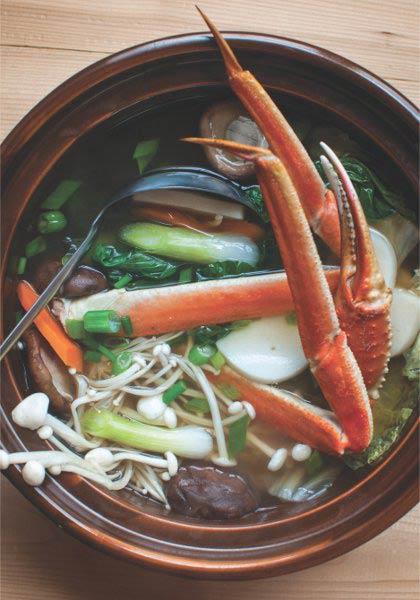

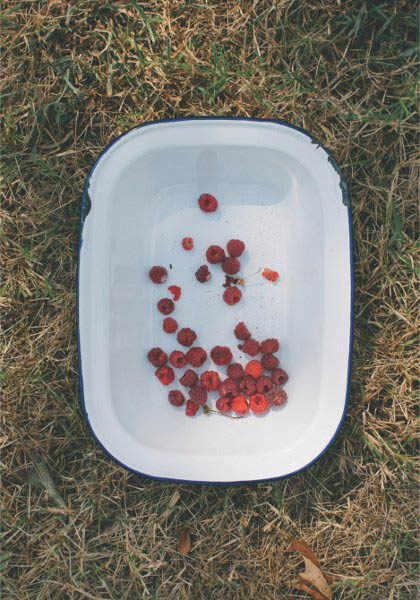
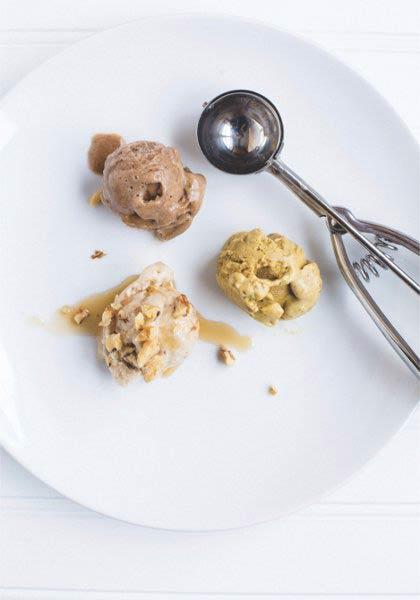
Banana Ice Cream
Humans have been flavoring ice in China for at least 5,000 years; Marco Polo brought flavored ice to Italy in the 13th century; and ice cream as we know it was created in the 17th century. Although nothing beats real, homemade ice cream, I can’t resist the simplicity and whole-foods nature of making ice cream out of frozen bananas.
SERVES:
2
PREP TIME:
2 MINUTES PLUS 4 HOURS
MAPLE WALNUT ICE CREAM
COOKING TIME:
5 MINUTES
1 LB. RIPE BANANAS (3 BANANAS), CUT INTO 2" CHUNKS
1/4 CUP WALNUTS
2 TBSP. MAPLE SYRUP
1. Put the bananas on a baking sheet and freeze until solid, at least 4 hours. Toast the walnuts on medium-low heat for about 5 minutes, then let cool and chop.
2. Add the frozen bananas to a food processor and process, stopping frequently to stir. Add the maple syrup and process to incorporate. When smooth, mix in the walnuts by hand and serve immediately.
PISTACHIO ICE CREAM
1 LB. RIPE BANANAS (3 BANANAS), CUT INTO 2" CHUNKS
1/4 CUP PISTACHIOS, COARSELY CHOPPED
1. Put the bananas on a baking sheet and freeze until solid, at least 4 hours. Add the frozen bananas to a food processor and process, stopping frequently to stir. Add the chopped pistachios and process until smooth; serve immediately.
MOCHA ICE CREAM
COOKING TIME:
5 MINUTES PLUS 1 HOUR TO SET
1 LB. RIPE BANANAS (3 BANANAS), CUT INTO 2" CHUNKS
1/4 CUP COLD STRONG COFFEE
1 TBSP. UNSWEETENED COCOA POWDER
1/2 TSP. VANILLA EXTRACT
2 TBSP. MAPLE SYRUP
1. Put the bananas on a baking sheet freeze until solid, at least 4 hours. Add the frozen bananas to a food processor and process, stopping frequently to stir. Add the coffee, cocoa powder, vanilla, and maple syrup and process to incorporate; remove when smooth. Return to the freezer until it reaches the desired hardness, about 1 hour.
Strawberry Granita
Granita is a semi-frozen dessert, similar to sorbet, that originated in Sicily and dates back to the Middle Ages. There are many variations of the dish, most associated with the texture; the longer you let the mixture freeze before breaking up the ice crystals, the less smooth it will be. I opted for the coarse version, which is more typical of its Sicilian origin.
SERVES:
4
PREP TIME:
10 MINUTES
FREEZING TIME:
8 HOURS
2 PINTS STRAWBERRIES, STEMS REMOVED
1 1/2 CUPS APPLE JUICE
1/2 CUP COLD WATER
1. Blend the strawberries, then strain out and discard any seeds. Combine the strawberry puree, apple juice, and water in a rimmed baking sheet. Place the baking sheet in the freezer and freeze for 4 hours. Use a fork to break up the ice crystals, then return to the freezer.
2. Repeat this process 2 more times, breaking up the ice crystals every 2 hours for a total of 8 hours of freezing time. Serve cold.
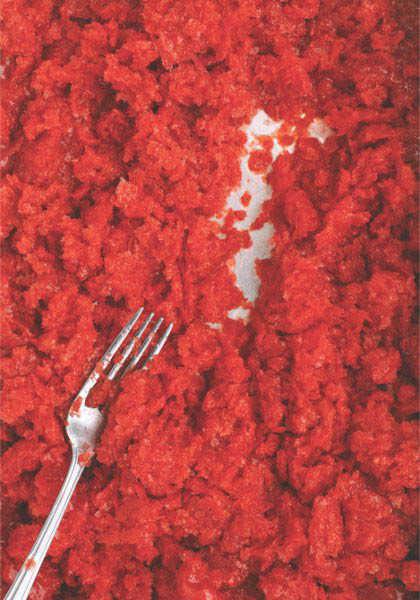
Almond Panna Cotta
Panna cotta is an Italian desert of unknown origin. Traditional recipes called for boiling fish bones to extract the collagen necessary to thicken this dish; today, gelatin powder is used. Panna cotta is often made with cream and milk, but almond milk variations like this one are also popular.
SERVES:
4
PREP TIME:
5 MINUTES, PLUS 4 HOURS TO SET
COOKING TIME:
20 MINUTES
2 CUPS UNSWEETENED ALMOND MILK
3 TBSP. HONEY
1 VANILLA BEAN, SPLIT (OR 1 TSP. VANILLA EXTRACT)
2 TBSP. HOT WATER
1 1/2 TSP. GELATIN POWDER
1. In a saucepan, combine the almond milk, honey, and vanilla bean (including its seeds). Bring to a simmer on medium-low heat, stirring frequently to dissolve the honey. Once simmering, remove from the heat and let sit for 5 minutes.
2. In a separate bowl, combine the hot water and gelatin, whisking with a fork until the gelatin dissolves. Pour into the almond milk mixture. If you used a vanilla bean, strain and discard the bean and seeds. Divide into 4 small bowls, glasses, or jars and refrigerate until set, about 4 hours. Serve with fresh fruit or berries.
3. Feel free to experiment with the flavors of panna cotta. One friend steeped a spiced tea bag in the almond milk as it simmered, which added some kick. Alternatively, you could add and melt 2 oz. dark chocolate as you finish simmering the almond milk. A traditional panna cotta is slightly less thick than custard; for a thicker variation, increase the amount of gelatin to 2 Tbsp.
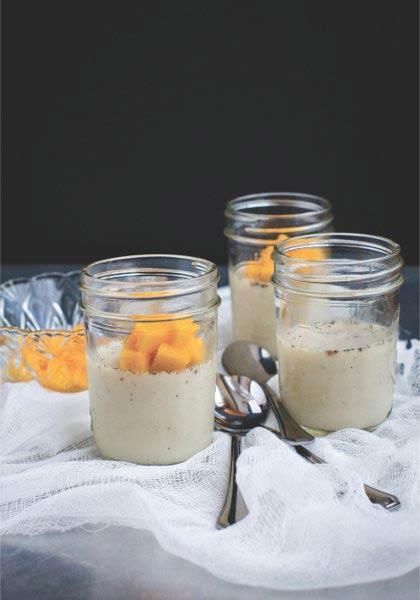
Chocolate Pudding
The etymology behind the word pudding is complicated. The first puddings were boiled and were similar to sausages, somewhat like the famous Scottish dish haggis. English puddings were historically either savory or sweet, with meat no longer associated with puddings after the 18th century; modern English puddings are usually savory rolls made from a batter of milk, flour, and eggs, similar to the American popover.
The American interpretation of pudding is most similar to custard. The Romans first made egg-based custards, which were both sweet and savory. In the Middle Ages, custard transformed into the sweet, pudding-like consistency it’s known for today. Sometime in the middle of the 19th century, Americans abandoned the traditional European boiled puddings. At the same time, instant custard powder was invented, which eliminated the need for fresh eggs. By the turn of the 20th century, instant custard, now termed pudding, became extremely popular in United States.
The flavor of this pudding is determined by the chocolate you use; dark chocolate will create a dark pudding. I recommend using a chocolate bar that you enjoy on its own.
There are two ways to make this dish dairy-free. Substituting coconut milk for heavy cream adds tropical notes, and the coconut milk thickens more quickly than cream. You can also use almond milk instead of heavy cream for a more even-flavored substitution, but be sure to double the arrowroot starch to get the right consistency.
SERVES:
6-8
PREP TIME:
20 MINUTES, PLUS 1 HOUR TO SOAK THE DATES AND 1 HOUR TO SET
COOKING TIME:
20 MINUTES
2 TBSP. ARROWROOT STARCH
1/4 TSP. SEA SALT
3 CUPS HEAVY CREAM
1/2 CUP WHOLE DATES, SOAKED FOR 1 HOUR AND PURÉED (ADD SOME OF THE SOAKING WATER IF TOO THICK TO PURÉE)
6 OZ. OF YOUR FAVORITE CHOCOLATE BAR, COARSELY CHOPPED
1 TSP. VANILLA EXTRACT
1. In a metal mixing bowl or double boiler, combine the arrowroot starch and salt. Slowly whisk in the cream and continue to whisk until well mixed. Suspend the bowl over a saucepan of simmering water and stir frequently until thickened, about 15-20 minutes. Mix in the dates and chocolate and incorporate until melted, about 2 minutes. Stir in the vanilla and remove from the heat. Pour everything through a mesh strainer into a measuring cup, stirring to help strain; discard any remaining date pulp, then pour the pudding into individual bowls or glasses. Refrigerate for 30 minutes to set.